面试题:如何能够保证T2在T1执行完后执行,T3在T2执行完后执行?——CountDownLatch原理
CountDownLatch的使用方式
CountDownLatch用于某个线程等待其他线程执行完任务再执行,与thread.join()功能类似。常见的应用场景是开启多个线程同时执行某个任务,等到所有任务执行完再执行特定操作,如汇总统计结果。
面试题:如何能够保证T2在T1执行完后执行,T3在T2执行完后执行?
join方法
可以使用join方法解决这个问题。比如在线程A中,调用线程B的join方法表示的意思就是: A等待B线程执行完毕后(释放CPU执行权),在继续执行。
public class RunnableJob {
public static void main(String[] args) throws InterruptedException {
Worker runnableJob = new Worker();
Thread t1 = new Thread(runnableJob, "T1");
Thread t2 = new Thread(runnableJob, "T2");
Thread t3 = new Thread(runnableJob, "T3");
t1.start();
//这里就是在main主线程中,调用t1线程的join方法。
//也就是main主线程要等待t1执行完成后才能继续往下执行
t1.join();
t2.start();
t2.join();
t3.start();
t3.join();
System.out.println("主线程执行完毕----");
}
}
class Worker implements Runnable{
public void run() {
Thread thread = Thread.currentThread();
try {
Thread.sleep(1000);
System.out.println(thread.getName()+"正在执行");
} catch (InterruptedException e) {
e.printStackTrace();
}
}
}
//输出
T1正在执行
T2正在执行
T3正在执行
主线程执行完毕----
CountDownLatch
倒计时计数器
CountDownLatch用于某个线程等待其他线程执行完任务再执行,可以被认为是加强版的join()。
public class CountDownLatchTest {
public static void main(String[] args) {
final CountDownLatch countDownLatch = new CountDownLatch(3);
new Thread("T1"){
public void run() {
try {
Thread.sleep(3000);
System.out.println(Thread.currentThread().getName()+"正在执行");
countDownLatch.countDown();
} catch (InterruptedException e) {
e.printStackTrace();
}
};
}.start();
new Thread("T2"){
public void run() {
try {
Thread.sleep(3000);
System.out.println(Thread.currentThread().getName()+"正在执行");
countDownLatch.countDown();
} catch (InterruptedException e) {
e.printStackTrace();
}
};
}.start();
new Thread("T3"){
public void run() {
try {
Thread.sleep(3000);
System.out.println(Thread.currentThread().getName()+"正在执行");
countDownLatch.countDown();
} catch (InterruptedException e) {
e.printStackTrace();
}
};
}.start();
System.out.println("等待三个线程执行完,主线程才能执行");
try {
//调用await()方法的线程会被挂起,它会等待直到count值为0才继续执行;
//或者等待timeout时间后count值还没变为0的话也会继续执行
countDownLatch.await();
// countDownLatch.await(20000, TimeUnit.MILLISECONDS);
} catch (InterruptedException e) {
e.printStackTrace();
}
System.out.println("主线程执行完毕");
}
}
//输出
等待三个线程执行完,主线程才能执行
T1正在执行
T3正在执行
T2正在执行
主线程执行完毕
调用了await后,主线程被挂起,它会等待直到count值为0才继续执行;因此只影响主线程的执行顺序一定要在T1 T2 T3之后,但T1 T2 T3之间的顺序互不影响
应用场景: 开启多个线程同时执行某个任务,等到所有任务执行完再执行特定操作,如汇总统计结果。
两者区别
相同点:都能等待一个或者多个线程执行完成操作,比如等待三个线程执行完毕后,第四个线程才能执行
不同点:join能让线程按我们预想的的顺序执行,比如线程1执行完了,线程2才能执行,线程2执行完,线程3才能执行,但是CountDownLatch就做不到.
当调用CountDownLatch的countDown方法时,N就会减1,CountDownLatch的await方法会阻塞当前线程,直到N变为零(也就是线程都执行完了),由于countDown方法可以用在任何地方,所以这里说的N个点,可以是N个线程,也可以是1个线程里的N个执行步骤。用在多线程时,只需把这个CountDownLatch的引用传递到线程中即可
CountDownLatch原理
从源码可知,其底层是由AQS提供支持,所以其数据结构可以参考AQS的数据结构,而AQS的数据结构核心就是两个虚拟队列: 同步队列sync queue 和条件队列condition queue,不同的条件会有不同的条件队列。
CountDownLatch对AQS的共享方式实现为:CountDownLatch 将任务分为N个子线程去执行,将 state 初始化为 N, N与线程的个数一致,N个子线程是井行执行的,每个子线程都在执行完成后 countDown() 1次, state 执行 CAS 操作并减1。在所有子线程都执行完成(state=0)时会unpark()主线程,然后主线程会从 await()返回,继续执行后续的动作。

CountDownLatch源码分析
类的继承关系
CountDownLatch没有显示继承哪个父类或者实现哪个父接口, 它底层是AQS是通过内部类Sync来实现的。
public class CountDownLatch {}
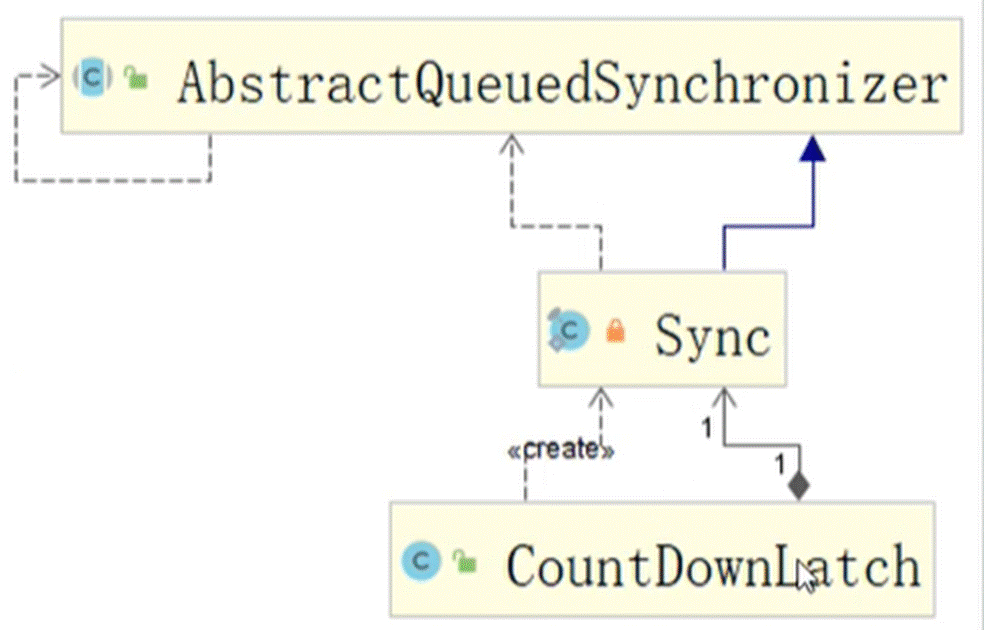
类的内部类
CountDownLatch类存在一个内部类Sync,继承自AbstractQueuedSynchronizer,其源代码如下。
private static final class Sync extends AbstractQueuedSynchronizer {
// 版本号
private static final long serialVersionUID = 4982264981922014374L;
// 构造器
Sync(int count) {
setState(count);
}
// 返回当前计数
int getCount() {
return getState();
}
// 试图在共享模式下获取对象状态
protected int tryAcquireShared(int acquires) {
return (getState() == 0) ? 1 : -1;
}
// 试图设置状态来反映共享模式下的一个释放
protected boolean tryReleaseShared(int releases) {
// Decrement count; signal when transition to zero
// 无限循环
for (;;) {
// 获取状态
int c = getState();
if (c == 0) // 没有被线程占有
return false;
// 下一个状态
int nextc = c-1;
if (compareAndSetState(c, nextc)) // 比较并且设置成功
return nextc == 0;
}
}
}
说明: 对CountDownLatch方法的调用会转发到对Sync或AQS的方法的调用,所以,AQS对CountDownLatch提供支持。
类的属性
可以看到CountDownLatch类的内部只有一个Sync类型的属性:
public class CountDownLatch {
// 同步队列
private final Sync sync;
}
类的构造函数
public CountDownLatch(int count) {
if (count < 0) throw new IllegalArgumentException("count < 0");
// 初始化状态数
this.sync = new Sync(count);
}
说明: 该构造函数可以构造一个用给定计数初始化的CountDownLatch,并且构造函数内完成了sync的初始化,并设置了状态数。
核心函数 - await函数
此函数将会使当前线程在锁存器倒计数至零之前一直等待,除非线程被中断。其源码如下
public void await() throws InterruptedException {
// 转发到sync对象上
sync.acquireSharedInterruptibly(1);
}
说明: 由源码可知,对CountDownLatch对象的await的调用会转发为对Sync的acquireSharedInterruptibly(从AQS继承的方法)方法的调用。
- acquireSharedInterruptibly源码如下:
public final void acquireSharedInterruptibly(int arg)
throws InterruptedException {
if (Thread.interrupted())
throw new InterruptedException();
if (tryAcquireShared(arg) < 0)
doAcquireSharedInterruptibly(arg);
}
说明: 从源码中可知,acquireSharedInterruptibly又调用了CountDownLatch的内部类Sync的tryAcquireShared和AQS的doAcquireSharedInterruptibly函数。
- tryAcquireShared函数的源码如下:
protected int tryAcquireShared(int acquires) {
return (getState() == 0) ? 1 : -1;
}
说明: 该函数只是简单的判断AQS的state是否为0,为0则返回1,不为0则返回-1。
- doAcquireSharedInterruptibly函数的源码如下:
private void doAcquireSharedInterruptibly(int arg) throws InterruptedException {
// 添加节点至等待队列
final Node node = addWaiter(Node.SHARED);
boolean failed = true;
try {
for (;;) { // 无限循环
// 获取node的前驱节点
final Node p = node.predecessor();
if (p == head) { // 前驱节点为头节点
// 试图在共享模式下获取对象状态
int r = tryAcquireShared(arg);
if (r >= 0) { // 获取成功
// 设置头节点并进行繁殖
setHeadAndPropagate(node, r);
// 设置节点next域
p.next = null; // help GC
failed = false;
return;
}
}
if (shouldParkAfterFailedAcquire(p, node) &&
parkAndCheckInterrupt()) // 在获取失败后是否需要禁止线程并且进行中断检查
// 抛出异常
throw new InterruptedException();
}
} finally {
if (failed)
cancelAcquire(node);
}
}
说明: 在AQS的doAcquireSharedInterruptibly中可能会再次调用CountDownLatch的内部类Sync的tryAcquireShared方法和AQS的setHeadAndPropagate方法。
- setHeadAndPropagate方法源码如下。
private void setHeadAndPropagate(Node node, int propagate) {
// 获取头节点
Node h = head; // Record old head for check below
// 设置头节点
setHead(node);
/*
* Try to signal next queued node if:
* Propagation was indicated by caller,
* or was recorded (as h.waitStatus either before
* or after setHead) by a previous operation
* (note: this uses sign-check of waitStatus because
* PROPAGATE status may transition to SIGNAL.)
* and
* The next node is waiting in shared mode,
* or we don't know, because it appears null
*
* The conservatism in both of these checks may cause
* unnecessary wake-ups, but only when there are multiple
* racing acquires/releases, so most need signals now or soon
* anyway.
*/
// 进行判断
if (propagate > 0 || h == null || h.waitStatus < 0 ||
(h = head) == null || h.waitStatus < 0) {
// 获取节点的后继
Node s = node.next;
if (s == null || s.isShared()) // 后继为空或者为共享模式
// 以共享模式进行释放
doReleaseShared();
}
}
说明: 该方法设置头节点并且释放头节点后面的满足条件的结点,该方法中可能会调用到AQS的doReleaseShared方法,其源码如下。
private void doReleaseShared() {
/*
* Ensure that a release propagates, even if there are other
* in-progress acquires/releases. This proceeds in the usual
* way of trying to unparkSuccessor of head if it needs
* signal. But if it does not, status is set to PROPAGATE to
* ensure that upon release, propagation continues.
* Additionally, we must loop in case a new node is added
* while we are doing this. Also, unlike other uses of
* unparkSuccessor, we need to know if CAS to reset status
* fails, if so rechecking.
*/
// 无限循环
for (;;) {
// 保存头节点
Node h = head;
if (h != null && h != tail) { // 头节点不为空并且头节点不为尾结点
// 获取头节点的等待状态
int ws = h.waitStatus;
if (ws == Node.SIGNAL) { // 状态为SIGNAL
if (!compareAndSetWaitStatus(h, Node.SIGNAL, 0)) // 不成功就继续
continue; // loop to recheck cases
// 释放后继结点
unparkSuccessor(h);
}
else if (ws == 0 &&
!compareAndSetWaitStatus(h, 0, Node.PROPAGATE)) // 状态为0并且不成功,继续
continue; // loop on failed CAS
}
if (h == head) // 若头节点改变,继续循环
break;
}
}
说明: 该方法在共享模式下释放。
所以,对CountDownLatch的await调用大致会有如下的调用链。
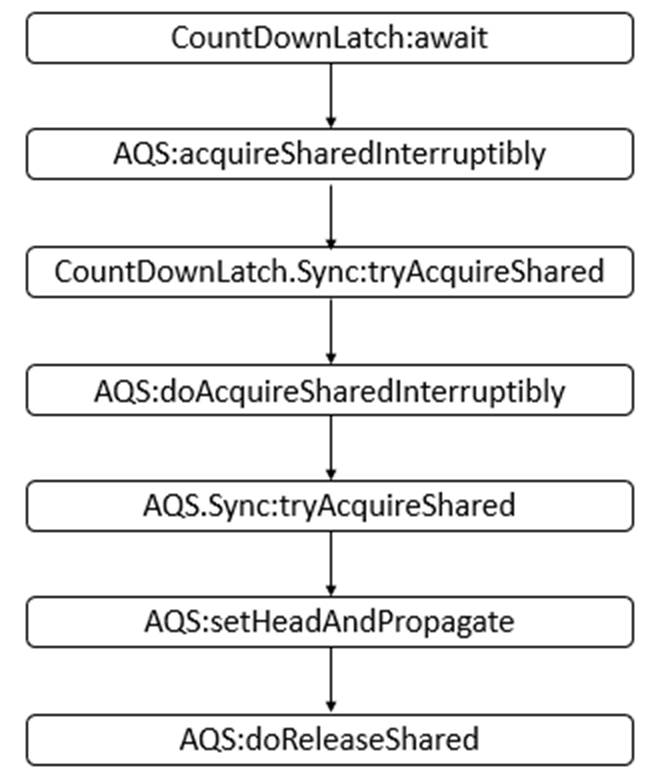
说明: 上图给出了可能会调用到的主要方法,并非一定会调用到
核心函数 - countDown函数
此函数将递减锁存器的计数,如果计数到达零,则释放所有等待的线程
public void countDown() {
sync.releaseShared(1);
}
说明: 对countDown的调用转换为对Sync对象的releaseShared(从AQS继承而来)方法的调用。
- releaseShared源码如下
public final boolean releaseShared(int arg) {
if (tryReleaseShared(arg)) {
// 当state状态为0了,才会执行这里
doReleaseShared();
return true;
}
return false;
}
说明: 此函数会以共享模式释放对象,并且在函数中会调用到CountDownLatch的tryReleaseShared函数,并且可能会调用AQS的doReleaseShared函数。
- tryReleaseShared源码如下
protected boolean tryReleaseShared(int releases) {
// Decrement count; signal when transition to zero
// 无限循环
for (;;) {
// 获取状态
int c = getState();
if (c == 0) // 没有被线程占有
return false;
// 下一个状态
int nextc = c-1;
if (compareAndSetState(c, nextc)) // 比较并且设置成功
return nextc == 0;
}
}
说明: 此函数会试图设置状态来反映共享模式下的一个释放。具体的流程在下面的示例中会进行分析。
- AQS的doReleaseShared的源码如下
private void doReleaseShared() {
/*
* Ensure that a release propagates, even if there are other
* in-progress acquires/releases. This proceeds in the usual
* way of trying to unparkSuccessor of head if it needs
* signal. But if it does not, status is set to PROPAGATE to
* ensure that upon release, propagation continues.
* Additionally, we must loop in case a new node is added
* while we are doing this. Also, unlike other uses of
* unparkSuccessor, we need to know if CAS to reset status
* fails, if so rechecking.
*/
// 无限循环
for (;;) {
// 保存头节点
Node h = head;
if (h != null && h != tail) { // 头节点不为空并且头节点不为尾结点
// 获取头节点的等待状态
int ws = h.waitStatus;
if (ws == Node.SIGNAL) { // 状态为SIGNAL
if (!compareAndSetWaitStatus(h, Node.SIGNAL, 0)) // 不成功就继续
continue; // loop to recheck cases
// 释放后继结点
unparkSuccessor(h);
}
else if (ws == 0 &&
!compareAndSetWaitStatus(h, 0, Node.PROPAGATE)) // 状态为0并且不成功,继续
continue; // loop on failed CAS
}
if (h == head) // 若头节点改变,继续循环
break;
}
}
说明: 此函数在共享模式下释放资源。
所以,对CountDownLatch的countDown调用大致会有如下的调用链
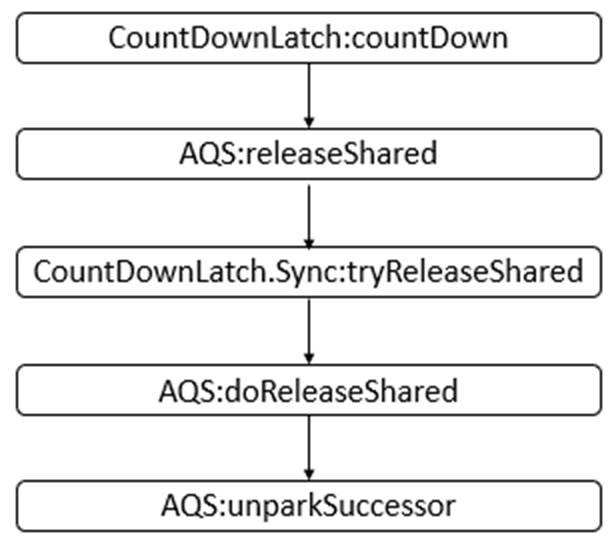
示例
下面给出了一个使用CountDownLatch的示例。
import java.util.concurrent.CountDownLatch;
class MyThread extends Thread {
private CountDownLatch countDownLatch;
public MyThread(String name, CountDownLatch countDownLatch) {
super(name);
this.countDownLatch = countDownLatch;
}
public void run() {
System.out.println(Thread.currentThread().getName() + " doing something");
try {
Thread.sleep(1000);
} catch (InterruptedException e) {
e.printStackTrace();
}
System.out.println(Thread.currentThread().getName() + " finish");
countDownLatch.countDown();
}
}
public class CountDownLatchDemo {
public static void main(String[] args) {
CountDownLatch countDownLatch = new CountDownLatch(2);
MyThread t1 = new MyThread("t1", countDownLatch);
MyThread t2 = new MyThread("t2", countDownLatch);
t1.start();
t2.start();
System.out.println("Waiting for t1 thread and t2 thread to finish");
try {
countDownLatch.await();
} catch (InterruptedException e) {
e.printStackTrace();
}
System.out.println(Thread.currentThread().getName() + " continue");
}
}
运行结果(某一次):
Waiting for t1 thread and t2 thread to finish
t1 doing something
t2 doing something
t1 finish
t2 finish
main continue
说明: 本程序首先计数器初始化为2。根据结果,可能会存在如下的一种时序图。
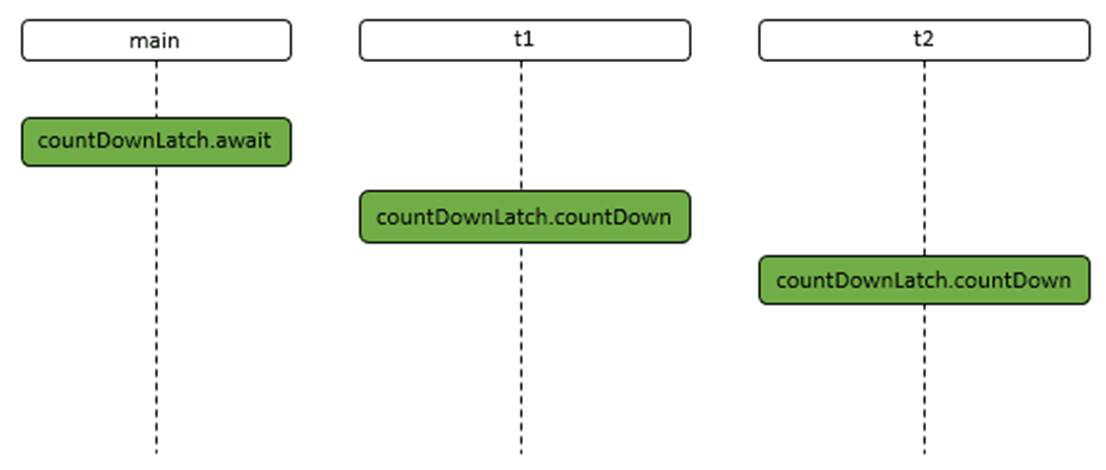
说明: 首先main线程会调用await操作,此时main线程会被阻塞,等待被唤醒,之后t1线程执行了countDown操作,最后,t2线程执行了countDown操作,此时main线程就被唤醒了,可以继续运行。下面,进行详细分析。
- main线程执行countDownLatch.await操作,主要调用的函数如下。
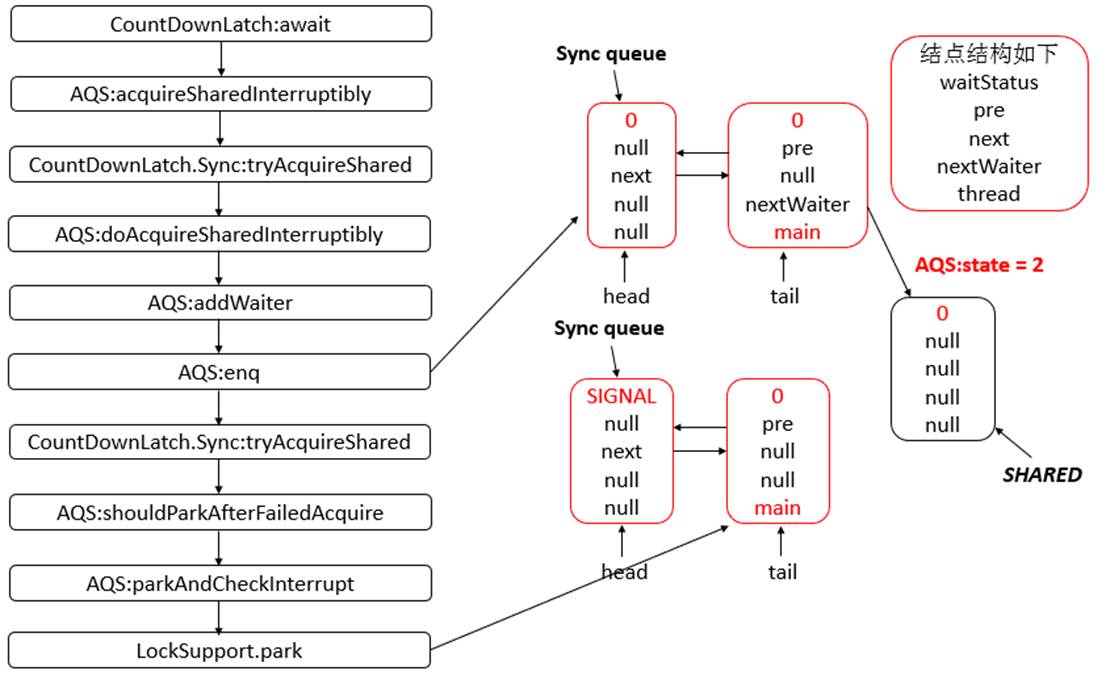
说明: 在最后,main线程就被park了,即禁止运行了。此时Sync queue(同步队列)中有两个节点,AQS的state为2,包含main线程的结点的nextWaiter指向SHARED结点。
- t1线程执行countDownLatch.countDown操作,主要调用的函数如下。

说明: 此时,Sync queue队列里的结点个数未发生变化,但是此时,AQS的state已经变为1了。
- t2线程执行countDownLatch.countDown操作,主要调用的函数如下。
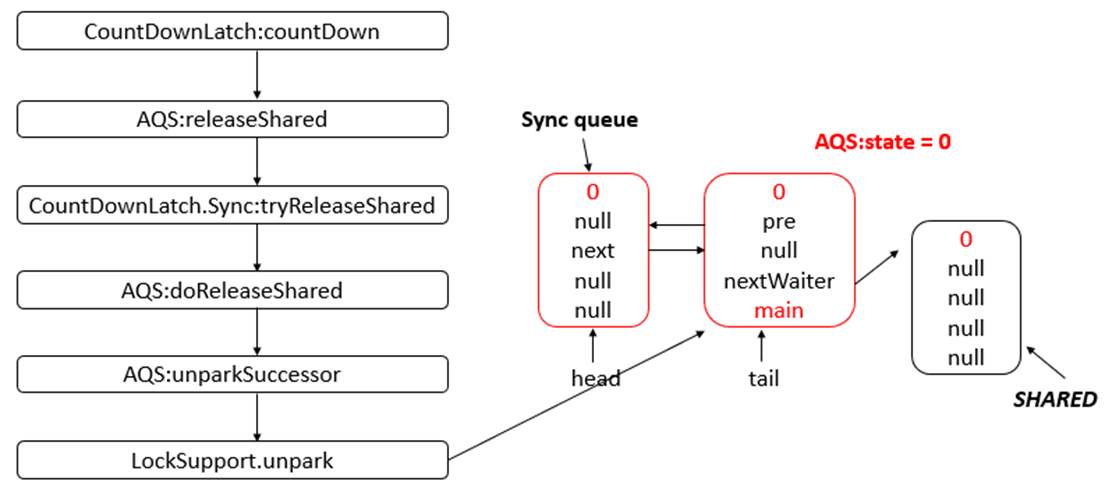
说明: 经过调用后,AQS的state为0,并且此时,main线程会被unpark,可以继续运行。当main线程获取cpu资源后,继续运行。
- main线程获取cpu资源,继续运行,由于main线程是在parkAndCheckInterrupt函数中被禁止的,所以此时,继续在parkAndCheckInterrupt函数运行。
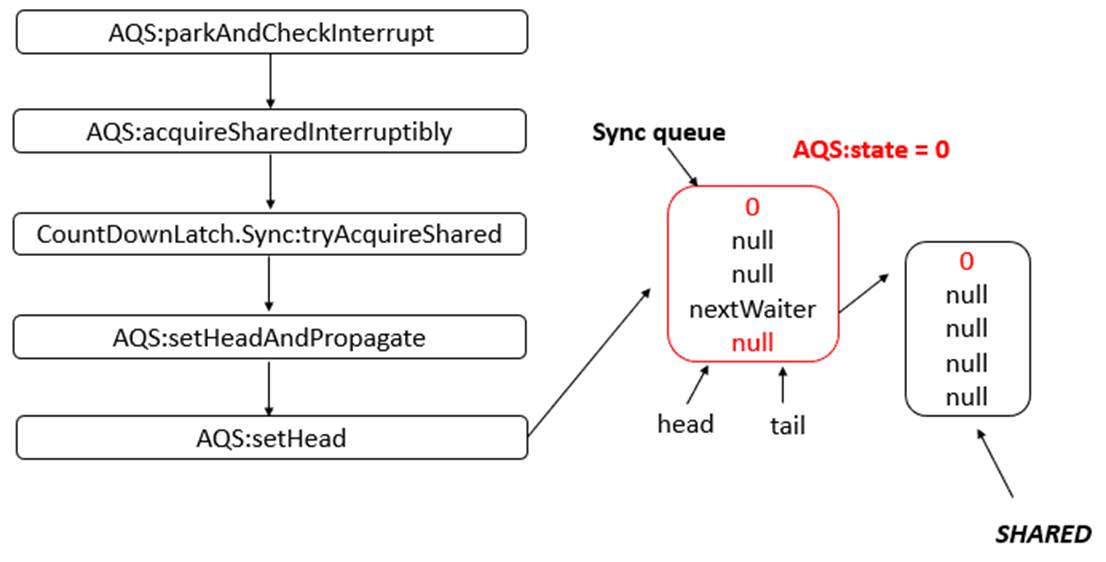
说明: main线程恢复,继续在parkAndCheckInterrupt函数中运行,之后又会回到最终达到的状态为AQS的state为0,并且head与tail指向同一个结点,该节点的额nextWaiter域还是指向SHARED结点
面试题专栏
Java面试题专栏已上线,欢迎访问。
- 如果你不知道简历怎么写,简历项目不知道怎么包装;
- 如果简历中有些内容你不知道该不该写上去;
- 如果有些综合性问题你不知道怎么答;
那么可以私信我,我会尽我所能帮助你。
本文来自在线网站:seven的菜鸟成长之路,作者:seven,转载请注明原文链接:www.seven97.top